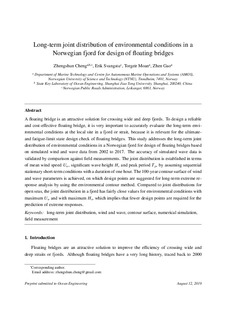| dc.contributor.author | Cheng, Zhengshun | |
| dc.contributor.author | Svangstu, Erik | |
| dc.contributor.author | Moan, Torgeir | |
| dc.contributor.author | Gao, Zhen | |
| dc.date.accessioned | 2020-01-10T13:26:32Z | |
| dc.date.available | 2020-01-10T13:26:32Z | |
| dc.date.created | 2019-10-30T19:01:11Z | |
| dc.date.issued | 2019 | |
| dc.identifier.issn | 0029-8018 | |
| dc.identifier.uri | http://hdl.handle.net/11250/2635734 | |
| dc.description.abstract | A floating bridge is an attractive solution for crossing wide and deep fjords. To design a reliable and cost-effective floating bridge, it is very important to accurately evaluate the long-term environmental conditions at the local site in a fjord or strait, because it is relevant for the ultimate- and fatigue-limit state design check of floating bridges. This study addresses the long-term joint distribution of environmental conditions in a Norwegian fjord for design of floating bridges based on simulated wind and wave data from 2002 to 2017. The accuracy of simulated wave data is validated by comparison against field measurements. The joint distribution is established in terms of mean wind speed , significant wave height and peak period , by assuming sequential stationary short-term conditions with a duration of one hour. The 100-year contour surface of wind and wave parameters is achieved, on which design points are suggested for long-term extreme response analysis by using the environmental contour method. Compared to joint distributions for open seas, the joint distribution in a fjord has fairly close values for environmental conditions with maximum and with maximum , which implies that fewer design points are required for the prediction of extreme responses. | nb_NO |
| dc.language.iso | eng | nb_NO |
| dc.publisher | Elsevier | nb_NO |
| dc.rights | Attribution-NonCommercial-NoDerivatives 4.0 Internasjonal | * |
| dc.rights.uri | http://creativecommons.org/licenses/by-nc-nd/4.0/deed.no | * |
| dc.title | Long-term joint distribution of environmental conditions in a Norwegian fjord for design of floating bridges | nb_NO |
| dc.type | Journal article | nb_NO |
| dc.type | Peer reviewed | nb_NO |
| dc.description.version | acceptedVersion | nb_NO |
| dc.source.volume | 191 | nb_NO |
| dc.source.journal | Ocean Engineering | nb_NO |
| dc.identifier.doi | 10.1016/j.oceaneng.2019.106472 | |
| dc.identifier.cristin | 1742487 | |
| dc.description.localcode | © 2019. This is the authors’ accepted and refereed manuscript to the article. Locked until 1.10.2021 due to copyright restrictions. This manuscript version is made available under the CC-BY-NC-ND 4.0 license http://creativecommons.org/licenses/by-nc-nd/4.0/ | nb_NO |
| cristin.unitcode | 194,64,20,0 | |
| cristin.unitname | Institutt for marin teknikk | |
| cristin.ispublished | true | |
| cristin.fulltext | postprint | |
| cristin.qualitycode | 1 | |

